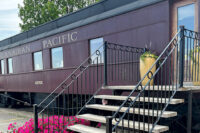SPC weighs options for emergency services staffing models
By Lethbridge Herald on May 17, 2022.
Justin Seward
Lethbridge Herald
Lethbridge’s chief of fire and EMS, Greg Adair, came before the Community Safety Standing Policy Committee on Thursday to present options for an operational staffing model for emergency services.
Challenges that are being faced include a 20 per cent increase in long distance transfers, a 58 per cent increase in responding to emergencies outside of Lethbridge, 47 per cent increase to EMS call volumes, the relocation of ambulances outside of Lethbridge to cover other communities, the loss of situational awareness of the ambulance due to the loss of EMS dispatch, and no additional ambulances in the system since 2015.
The SPC voted unanimously to recommend that council support hiring and training the additional eight firefighters in 2022, using the BAU 660-242 at $884,600, and recognizing ongoing mitigating efforts to reduce any future impact on the taxes for the 2023-2026 operating budget.
“All of these changes, as you can see here, has equated that our EMS resources are no longer available to aid in fire suppression,” said Adair.
“When we entered into our EMS contract back in 2009 and again in 2014, our contract allowed for our EMS resources to aid in fire suppression. But with all the changes that we talked about here, are no longer available. We’re unable to respond with an effective response for us from a fire perspective.”
Administration looked over four options to see what the best path forward would be to overcome challenges.
Option A was a Parallel Service-Base Case which would provide fire/rescue the resources to respond to medical emergencies in a safe and effective manner.
“LFES continues to transition from three-person to four-person fire apparatus as previously directed by council. This transition started in 2021 to ensure LFES has a standard deployment of 24 firefighters on each platoon,” reads a statement in the presentation report.
There would be a net increase of 21 firefighters on top of current staffing levels.
“What we’re looking for here is for council to support continuing with a parallel EMS service going forward,” said Adair.
This would require LFES to hire eight additional staff in the fall of 2022, said Adair.
The funding would come through BAU 660-442, totalling $884,600, to pay for wages and training. LFES would incur ongoing costs of approximately $1-1.3 million per year. The remaining 13 positions wouldn’t be hired until 2023-2025.
The total cost would be $3.4 million by 2026 with no additional tax pressure.
Segregated services in Option B would see LFES staffing while running both EMS and fire/rescue as separate services.
“LFES no longer relies on cross-trained paramedics as supplemental firefighters, though the City continues delivery of EMS services under contract with AHS. This option requires, at minimum, the same number of firefighters but potentially more than Option A (21 additional staff), and assumes cross-training of staff would no longer be required,” as read in the agenda.
The additional staff would cost $3.4 million.
Option C would see LFES go to a fire-only service where the city would provide fire/rescue response, but not EMS. As result, paramedic training would no longer be required for firefighters, cost and revenues would be removed for EMS and a reduced level of EMS service could be provided if LFES doesn’t provide it.
Furthermore, there would be a decrease of 33 paramedics and an increase of $725,000 annually, not including medical first response.
“We would need an additional 21 firefighters to ensure that we have the effective fire response,” said Adair.
The last option would be to stay status quo.
“Well, the challenges that we’re trying to overcome, because EMS resources are not available anymore like they have been in the past, is we don’t have an adequate effective fire response force to ensure that we could respond to fire events safely and effectively,” said Adair.
“From that, we’re also struggling to ensure that we can meet the services level put forward by council due to staffing challenges. Currently, we have to occasionally shut down ambulances and fire stations due to lack of staffing.
“If we’re to continue down the status quo model, it would be a piece that would have to come back to council and look for direction on what service level change they would like to achieve.”
Administration suggests going with Parallel Service-Base Case which would not create an increase in taxes.
Committee member John Middleton-Hope agreed funding the additional staff through the BAU accounts in the first option would benefit in 2022, but does not address the next 30 years and redirected to Adair to further explain.
“As we went away from our last meeting with this group, we thought how we can get more creative to try not to create a tax pressure on our citizens,” said Adair.
“So what we looked at is we went back and looked at our operating budget and we thought is there any way that we can absorb the ongoing costs of these eight individuals into our current operating budget? And what we are doing is we are looking at to do that and that’s what we are doing today, is that ongoing funding will actually come out of our operating budget.”
29-28




